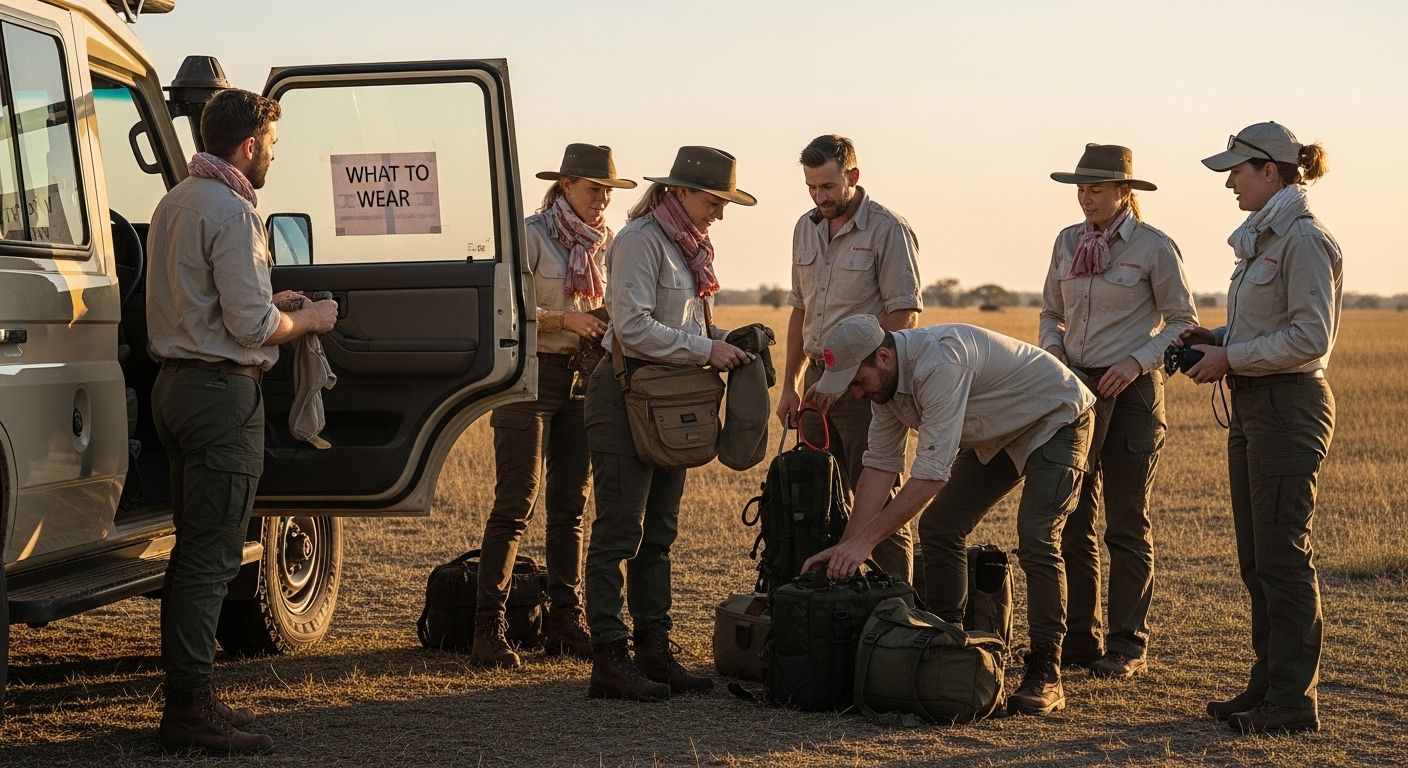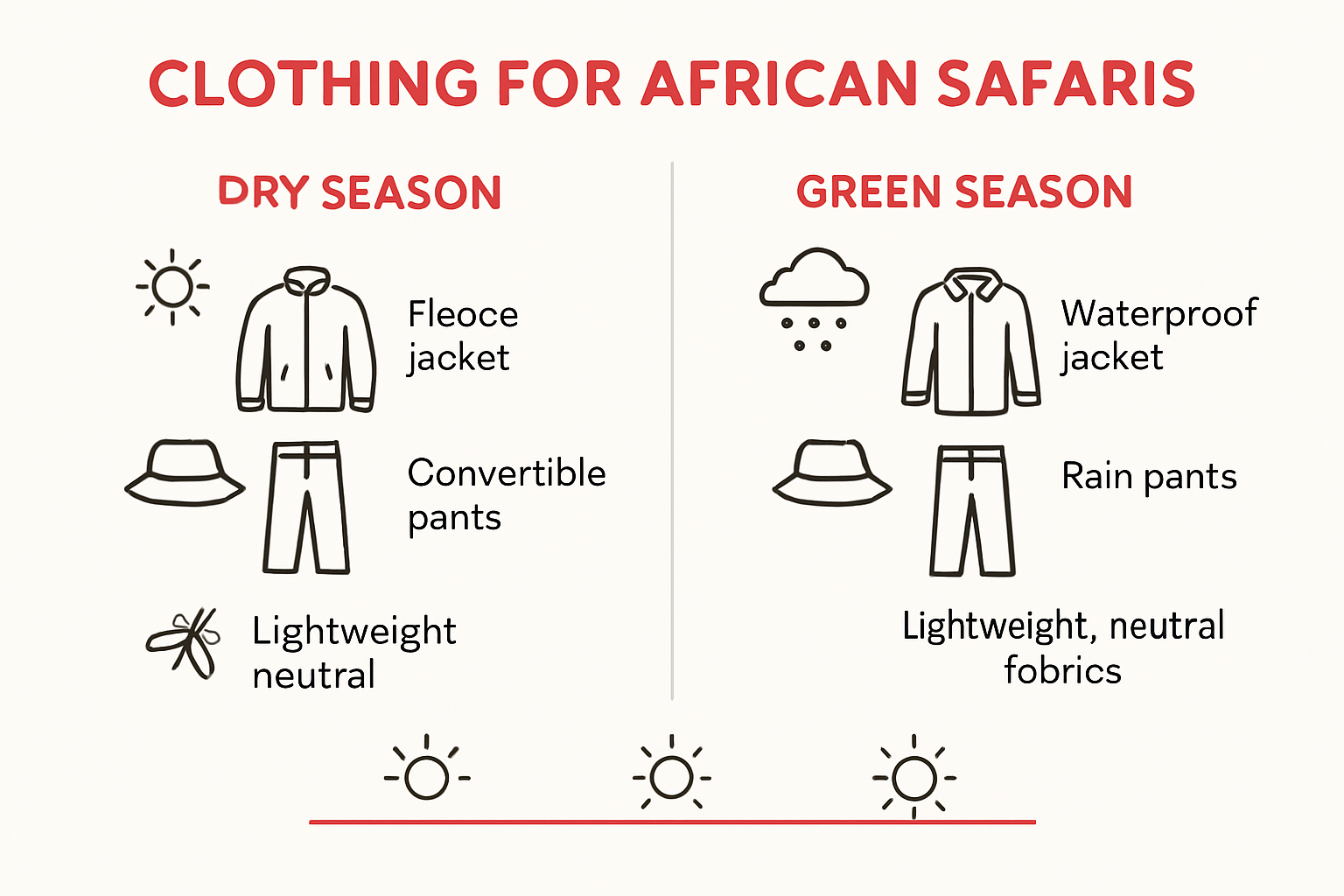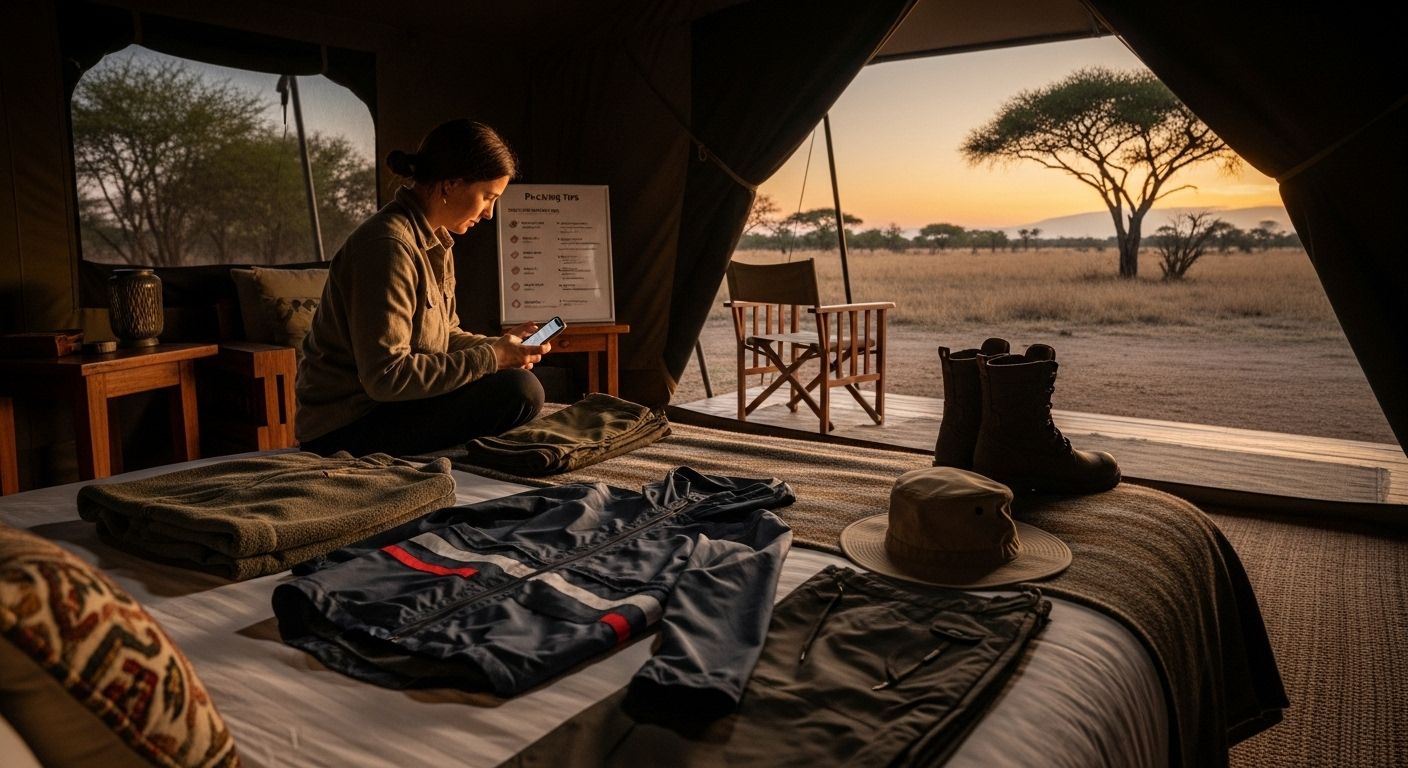What to Wear on Safari in 2025: Essential Packing Guide
Full Disclosure: Our AI Assistant Writes These!
While we're out in the bush tracking leopards, dodging elephants, and trying to get the perfect sunset shot, our trusty AI companion is back at camp, diligently crafting these blog posts. Don't worry though - it's been trained on years of real safari experiences and only occasionally suggests that tourists should pet the lions. (Please don't pet the lions. The AI was joking. We hope.)
The real reason? SEO loves fresh content, and we love fresh adventures. So while our AI handles the keywords and search rankings, we're out there finding the next hidden waterhole, secret viewpoint, or that one tree where the leopards always hang out. Win-win, really!
What to Wear on Safari in 2025: Essential Packing Guide

Deciding what to wear on safari can shape your whole African adventure. Most folks reach for khakis and hope for the best, but the science behind safari gear might surprise you. In fact, wearing dark blue can actually attract tsetse flies and lead to bites, turning a dream trip into a bug-ridden nightmare. The right choices do more than help you blend in, they can make the difference between comfort and chaos on the savannah.
Table of Contents
- Best Clothing Choices For African Safaris
- Footwear And Accessories For Every Adventure
- Weather-Ready Outfits For Different Safari Seasons
- Practical Packing Tips For All Traveller Types
Quick Summary
| Takeaway | Explanation |
|---|---|
| Choose breathable, moisture-wicking fabrics | Fabrics like nylon and merino wool regulate temperature, enhancing comfort in varying conditions during your safari. |
| Opt for neutral colours to blend in | Earthy tones such as khaki and olive green help avoid startling wildlife and are practical for your safari wardrobe. |
| Layer your clothing for changing temperatures | Start with a moisture-wicking base, add insulation, and top with a windproof layer to adapt to varying conditions throughout the day. |
| Invest in supportive footwear | Closed-toe hiking boots with good traction and ankle support are essential for navigating rugged terrains safely and comfortably. |
| Pack essential documentation and a first aid kit | Ensure your passport is valid, carry medical supplies, and utilize electronic backups to safeguard against emergencies during travel. |
Best Clothing Choices for African Safaris
Planning your safari wardrobe requires strategic thinking beyond simple fashion. The right clothing can significantly impact your comfort, safety, and overall safari experience in 2025. According to the Centers for Disease Control and Prevention, proper clothing selection is crucial for protecting yourself from environmental challenges during wildlife adventures.
Fabric and Color Selection
Choosing the right fabrics and colors is more than a style decision. According to the Smithsonian Magazine, moisture-wicking fabrics are essential for managing temperature fluctuations and maintaining comfort in diverse African terrains. Opt for lightweight, breathable materials like technical nylon, merino wool, and quick-drying synthetic blends.
Color Considerations
- Neutral Tones: Stick to khaki, tan, olive green, and soft browns
- Avoid Bright Colors: White, red, and vibrant patterns can startle wildlife
- Dark Blue: Potentially attracts tsetse flies, so best avoided
The goal is to blend into the natural environment while staying comfortable and protected. Lightweight, long-sleeved shirts and full-length pants not only provide sun protection but also create a barrier against insects and thorny vegetation.
Layering for Unpredictable Conditions
African safari environments present dramatic temperature variations. Morning game drives can start chilly, while midday temperatures soar. Effective layering becomes your temperature management strategy. Start with a moisture-wicking base layer, add an insulating mid-layer like a lightweight fleece, and top with a windproof outer layer.
Key layering pieces include:
- Thermal Underwear: Thin, lightweight base layers
- Fleece Jacket: Provides warmth without bulk
- Lightweight Rain Jacket: Protection against unexpected showers
Accessories play a critical role in your safari wardrobe. A wide-brimmed hat offers sun protection, while lightweight neck gaiter or buff can shield you from dust and provide additional warmth during early morning drives. Sturdy, comfortable walking shoes with ankle support are non-negotiable for both game drives and potential walking safaris.
Pro tip: Check our guide on walking safaris to understand why appropriate footwear and clothing are essential for these immersive wildlife experiences.
Remember that safari clothing is about functionality. Your wardrobe should protect you from the elements, help you blend with the environment, and provide comfort during long days of wildlife observation. Prioritize practicality over style, but don’t compromise on quality or comfort.
Footwear and Accessories for Every Adventure
Choosing the right footwear and accessories can make or break your safari experience. These critical elements provide protection, comfort, and functionality across diverse African terrains and wildlife environments. How to Plan a Safari: 2025 Guide for All Travellers emphasizes the importance of strategic gear selection for optimal safari enjoyment.
Essential Safari Footwear
Safari footwear demands more than aesthetic appeal. According to The Safari Store, your shoes must withstand rugged terrain, provide ankle support, and offer protection from environmental challenges. Prioritize closed-toe hiking boots or robust walking shoes with thick, treaded soles that can handle rocky landscapes, sandy paths, and uneven ground.
Footwear Selection Criteria
- Ankle Support: Prevents injuries on uneven terrain
- Water Resistance: Protects against morning dew and occasional rain
- Breathability: Allows feet to remain cool in hot conditions
Consider bringing two pairs of comfortable walking shoes. One pair for game drives and another for camp activities. Breaking in your shoes before the trip prevents blisters and ensures maximum comfort during your adventure.
Protective Accessories and Sun Defense
Accessories are not mere fashion statements but essential survival tools in safari environments. Anderson Harvey Travel Guides recommend versatile accessories that serve multiple protective functions. A wide-brimmed hat is crucial for shielding your face and neck from intense African sunlight, while a lightweight scarf or buff provides multipurpose protection against dust, sun, and unexpected temperature drops.
To help you choose the best accessories for sun and environmental defence, here’s a quick summary of their functions and benefits:
| Accessory | Function | Benefit |
|---|---|---|
| Wide-Brimmed Hat | Shields face and neck from the sun | Prevents sunburn and heatstroke |
| Lightweight Buff/Scarf | Protects against dust & temperature shifts | Multipurpose coverage, adds warmth |
| High-Quality Sunglasses | Filters UV rays, wraps around eyes | Reduces glare, shields from sun damage |
| Lightweight Gloves | Covers hands on cool mornings/evenings | Keeps hands warm, protects skin |
Key protective accessories include:
- Wide-Brimmed Hat: Provides comprehensive sun protection
- Lightweight Buff/Scarf: Versatile protection against dust and temperature variations
- High-Quality Sunglasses: UV protection with wrap-around design
- Lightweight Gloves: Protection during early morning and evening game drives
The right accessories transform your safari experience from merely observing wildlife to immersing yourself comfortably in the natural environment. Consider materials that are quick-drying, lightweight, and offer sun protection.
Technical Gear and Personal Comfort
Beyond traditional accessories, consider technical gear that enhances your safari experience. A compact, high-quality binocular set allows for detailed wildlife observation without bulky equipment. Portable power banks ensure your camera and communication devices remain charged during extended game drives.
Additional recommended technical accessories:
- Compact Binoculars: Lightweight, high-magnification models
- Portable Charger: Ensures continuous device connectivity
- Moisture-Wicking Neck Gaiter: Temperature and dust management
- Compact First Aid Kit: Basic medical supplies for emergencies
Remember that every accessory should serve a practical purpose. Prioritize lightweight, multipurpose items that minimize luggage weight while maximizing functionality. Your goal is to be prepared, comfortable, and ready to fully experience the extraordinary wildlife and landscapes of your African safari adventure.
Weather-Ready Outfits for Different Safari Seasons
African safari destinations present a complex climate challenge that demands strategic clothing selections. How to Book a Safari: A 2025 Guide for Every Traveller highlights the importance of understanding seasonal variations to pack effectively. According to National Geographic, your clothing strategy must adapt to dramatic temperature shifts and diverse environmental conditions.

Dry Season Safari Wardrobe
The dry season from May to October represents the peak safari period with predictable weather patterns. Natural Habitat Adventures recommends a layered approach for managing temperature variations. Morning game drives can start surprisingly chilly, with temperatures potentially dropping to 10-15 degrees Celsius, necessitating warm layers like fleece pullovers and lightweight jackets.
To clarify how safari clothing needs change by season, the table below compares the dry and green seasons and highlights key packing items for each.
| Feature/Clothing Type | Dry Season (May–Oct) | Green Season (Nov–Apr) |
|---|---|---|
| Morning Temperatures | 10–15°C, can be very chilly | Mild, more humid |
| Midday Temperatures | Up to 30°C, can get hot | Warm to hot, often humid |
| Key Upper Body Layers | Fleece jacket, warm base layer | Long-sleeved quick-dry shirts |
| Must-have Outerwear | Lightweight wind/rain jacket | Waterproof, breathable rain jacket |
| Legwear | Convertible trousers, thermal base layer | Quick-drying, water-resistant trousers |
| Socks | Wool, for warmth and breathability | Lighter wool/synthetic, fast drying |
| Additional Accessories | Warm hat, gloves for morning | Hat, scarf for sun and rain protection |
Key dry season clothing essentials include:
- Thermal Base Layers: Thin, insulating undergarments
- Convertible Hiking Pants: Adaptable to temperature changes
- Lightweight Fleece Jacket: Warmth without bulk
- Wool Socks: Temperature regulation and blister prevention
During midday, temperatures can rapidly climb to 30 degrees Celsius, requiring quick clothing adjustments. Zippered pants that convert into shorts provide maximum flexibility, allowing you to adapt swiftly to changing conditions.
Green Season Clothing Strategies
The green season from November to April introduces unique clothing challenges with increased humidity and potential rainfall. According to Ultimate Kilimanjaro, this period demands moisture-resistant clothing and strategic layering. A waterproof rain jacket with a hood becomes essential, protecting you from sudden tropical downpours while maintaining breathability.
Green season packing recommendations:
- Quick-Drying Fabrics: Lightweight, moisture-wicking materials
- Waterproof Rain Jacket: Compact and breathable
- Long-Sleeved Shirts: Protection against increased insect activity
- Lightweight Rain Pants: Optional but recommended for extended outdoor activities
Color selection remains crucial. Stick to neutral earth tones like khaki, olive green, and soft browns to blend seamlessly with the landscape and avoid attracting unwanted insect attention.
Universal Safari Clothing Principles
Regardless of season, certain clothing principles remain constant. Prioritize lightweight, breathable fabrics that offer sun protection and insect resistance. Opt for clothing with built-in ultraviolet protection factor (UPF) to shield against intense African sunlight.
Accessories play a critical role in weather adaptation:
- Wide-Brimmed Hat: Sun and heat protection
- Lightweight Neck Gaiter: Dust and temperature management
- Compact Gloves: Early morning and evening warmth
- Sunglasses: UV protection with wraparound design
Remember that safari clothing is about versatility and protection. Your wardrobe should allow you to transition seamlessly between cool mornings, hot afternoons, and potentially rainy environments. Invest in quality, multipurpose garments that offer comfort, protection, and the flexibility to enjoy wildlife experiences across different seasonal conditions.
Practical Packing Tips for All Traveller Types
Packing for an African safari requires strategic planning that goes beyond simple clothing selection. Africa Geographic emphasizes that your packing approach must accommodate diverse traveler types, from solo adventurers to family groups, each with unique requirements.
Essential Documentation and Medical Preparedness
Before considering clothing and gear, prioritize critical documentation. Safari.co.za recommends ensuring your passport is valid for at least six months beyond your travel dates, with sufficient blank pages for entry stamps. Travelers should carry multiple copies of important documents: one physical set stored separately from originals, and digital copies securely backed up online.
Medical preparation is equally crucial:
- Prescription Medications: Bring sufficient supply with original prescriptions
- Travel Insurance: Comprehensive coverage including medical evacuation
- First Aid Kit: Include personal medications, basic wound care supplies
- Vaccination Documentation: Proof of required immunizations
Consider reviewing our safari safety recommendations for comprehensive health and safety guidance specific to African travel.
Strategic Luggage and Equipment Selection
According to National Geographic, luggage selection can significantly impact your travel experience. Soft-sided, flexible bags are recommended over rigid suitcases, particularly for safaris involving light aircraft transfers. Weight restrictions can be stringent, so prioritize multipurpose items that minimize bulk.
Equipment recommendations for all traveler types:
- Photography Gear: Extra batteries, multiple memory cards
- Portable Chargers: Universal adapters with multiple USB ports
- Compact Binoculars: Lightweight, high-magnification models
- Lightweight Daypack: For carrying essentials during game drives
Universal Packing Principles
Regardless of your traveler type, certain packing principles remain consistent. Africa Geographic highlights the importance of versatile, neutral-colored clothing that offers protection and blends with the environment. Pack clothing that can be layered, washed easily, and dried quickly.
For clarity, here’s a checklist table of universal safari packing strategies mentioned, allowing you to quickly confirm what to prepare:
| Item/Strategy | Why It Matters | Packed? |
|---|---|---|
| Clothing Layers | Adapt to temperature changes | [ ] |
| Neutral Colours | Blend in to avoid startling wildlife | [ ] |
| Moisture-Wicking Fabrics | Stay cool, dry quickly | [ ] |
| Compact Accessories | Reduce bag weight, increase utility | [ ] |
| Documentation (physical/digital) | Essential for travel and emergencies | [ ] |
| First Aid & Medication | Health and safety during safari | [ ] |
| Portable Chargers | Keep devices powered | [ ] |
Special considerations exist for different traveler types. Solo travelers might prioritize compact, lightweight gear, while family groups need more comprehensive medical supplies and versatile clothing options. Budget travelers should focus on multipurpose items that reduce overall luggage weight and potential additional fees.

Remember that successful safari packing is about balance. Each item should serve a specific purpose, offering protection, comfort, and practicality without unnecessary complexity. By carefully selecting your gear and understanding your specific travel needs, you’ll be well-prepared for an unforgettable African safari adventure.
Frequently Asked Questions
What should I wear on safari in 2025?
To ensure comfort and safety, opt for lightweight, moisture-wicking fabrics in neutral earthy tones like khaki and olive green. Long-sleeved shirts and full-length trousers are recommended for sun protection and insect defense.
How do I layer clothing for safari?
Start with a moisture-wicking base layer, followed by an insulating mid-layer like a fleece jacket, and top it off with a windproof outer layer. This strategy helps you adapt to the significant temperature changes throughout the day.
What type of footwear is best for a safari?
Closed-toe hiking boots with good ankle support are essential for navigating rugged terrains. Choose footwear that is breathable, water-resistant, and has thick, treaded soles to ensure comfort and safety.
Why are neutral colors important for safari clothing?
Neutral tones help you blend into the natural environment, minimizing the chances of startling wildlife. Bright colors can also attract insects like tsetse flies, so it’s best to stick to subdued shades for your safari wardrobe.
Ready to Transform Your Safari Wardrobe into the Ultimate Adventure?
Struggling to decide what to wear on safari is more than a small detail. The wrong fabrics or colours can leave you exposed to insects, drastic temperature changes, and missed wildlife moments. You deserve to feel safe and comfortable, whether you are catching the morning sun in the Serengeti or braving a chilly drive in Kruger. Our safari planning experts understand every challenge you have read about in this essential guide. From layering tips for unpredictable weather to selecting gear that blends into nature, we know the secrets to a seamless and memorable journey.

Start planning your once-in-a-lifetime safari with Africa Awesome now. Browse authentic safari tours and tailored packages or speak directly with our travel specialists for personalised gear advice and hassle-free booking. Secure your spot today and step into Africa with confidence.
Recommended
-
[ Top Fashion Staples for Women: Your 2025 Essential Guide
– Be Juliet](https://bejuliet.com/blogs/blog/fashion-staples-for-women-2025-essential-guide)
-
Seasonal Clothing Storage Ideas for Stylish Homes 2025 – BLUSHBEES USA